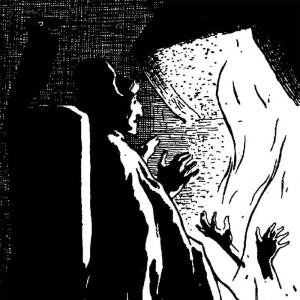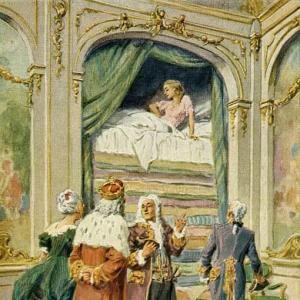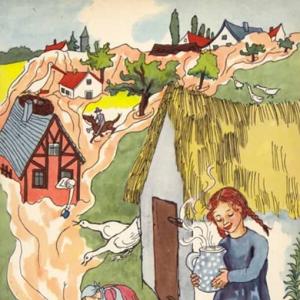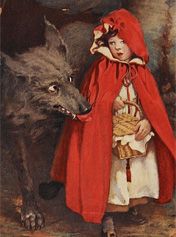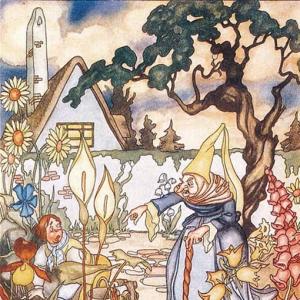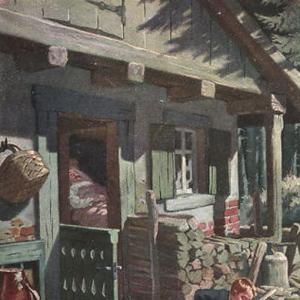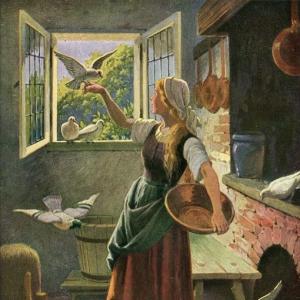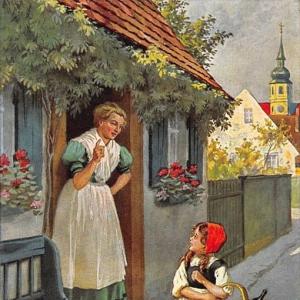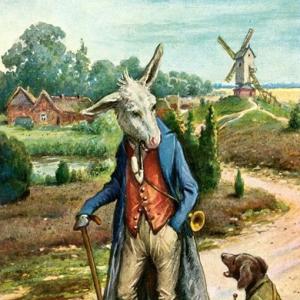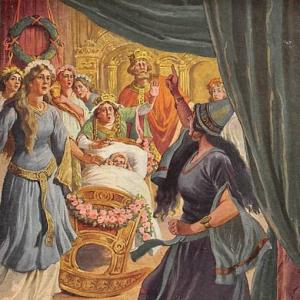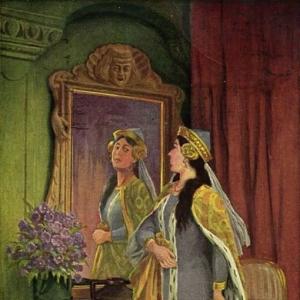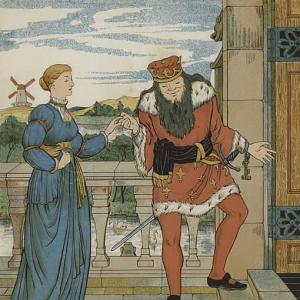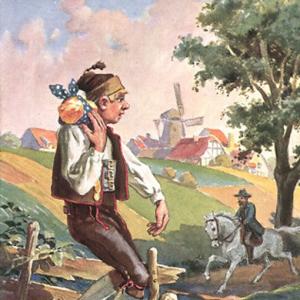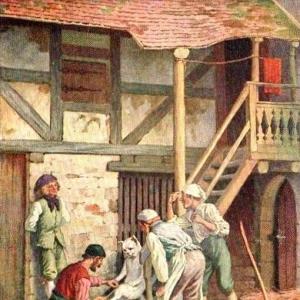Reading time: 11 min
There is an old fairy tale: „The Thorny Road of Honor was trodden by a marksman named Bryde, to whom came great honor and dignity, but not until after manifold adversities and peril of life.“ More than one of us had heard that tale in childhood, and perhaps read it in later years, and thought of his own unsung „thorny road“ and „manifold adversities.“ Romance and reality are very nearly alike, but romance has its harmonious ending here on earth, while reality more often delays it and leads us to time and eternity.
The history of the world is a magic lantern, showing us picture slides against the dark backgrounds of the ages, of how the benefactors of mankind, the martyrs of progress, have trodden their Thorny Roads of Honor.
From all times, from all lands, these pictures of splendor come to us; each picture lasts a moment only, yet it is a whole lifetime of struggles and triumphs. Let us glance at a few in the ranks of the marytrs (NB= martyrs), those ranks which will never be filled until earth itself shall pass a way.
We see a crowded theater! The Clouds of Aristophanes is sending forth to the audience a river of mirth and mockery. The stage of Athens is ridiculing, in both body and mind, her most remarkable man, who was the shield and defense of the people against the Thirty Tyrants. Socrates, who in the heat of battle rescued Alcibiades and Xenophon, whose spirit soared above the deities of the ancient world, is here in person. He has risen from the spectators‘ bench and has stepped forward, so that the mocking Athenians may decide whether he and the stage caricature resemble each other. There he stands erect before them, and in high spirit he is high above them.
You green, juicy, poisonous hemlock, be you, and not the olive tree, the shadowy symbol of this Athens!
Seven cities claimed to be the birthplace of Homer-that is, after he was dead. But look at him in his lifetime! Through these same cities he wanders, reciting his verses for a pittance. Care for the morrow turns his hair gray. He, mightiest of seers, is blind and alone; and the sharp thorns tear the mantle of the king of poesy.
His songs yet live, and in them alone live still the gods and heroes of olden times.
Picture after picture leaps forth from the morning land and the evening land, far separated by time and space, yet all with the same thorny path, where the thistle never bears blossoms till it adorns the grave.
Under the palm trees walk swaying camels, laden with indigo and other precious gifts, sent by the ruler of the land to him whose songs are the people’s delight and the country’s pride. He whom spite and slander drove into exile is found again, for the caravan draws near the little town where he has taken refuge. But a poor corpse is being carried out of the gate, and the caravan is stopped. The dead is the very man they seek, Firdausi; ended is his Thorny Road of Honor.
There sits an African Negro, with blunt features, thick lips, and black kinky hair, begging on the marble steps of the palace in Portugal’s capital. He is the faithful slave of Camöens. If it were not for him and the coppers that he begs, his master, the singer of The Lusiad, would have starved to death. Now an expensive monument rises over the grave of Camöens.
Still another picture. Behind iron bars a man appears, ghostly white, with a long and matted beard. „I have made an invention!“ he cries. „The greatest in centuries; and for more than twenty years they have kept me caged up here!“
„Who is he?“
„A lunatic,“ replies the keeper. „What crazy ideas a man may get! He thinks people could move along by steam power!“ It is Salomon de Caus, inventor of the steam engine. His prophetic words have not been clear enough for a Richelieu, and he dies imprisoned in a madhouse.
Here stands Columbus, whom once street boys pursued and mocked at, because he would discover a new world. He has discovered it! The bells of jubilation ring at his triumphant return; but soon the bells of envy sound more loudly still. The world discoverer, who raised the American land of gold from the ocean and gave it to his king, is rewarded with chains of iron. He asks that they be laid in his coffin, to show the world how a man is valued in his own age.
Picture rushes after picture, for rich is the Thorny Road of Honor.
Here in dismal gloom sits he who measured the heights of the moon mountains, who forced his way out among the planets and stars of space-mighty Galileo, who could see and hear the earth itself turning beneath him. Blind and deaf he sits now in his old age, suffering wracking pain and neglect, hardly able to lift his foot-that foot which once, when the words of truth were blotted out, he stamped on the earth in mental agony, crying out, „Yet it moves!“
Here stands a woman with the heart of a child, with inspiration and faith. She bears her banner before the fighting army and brings victory and freedom to her motherland. There is shouting-and the fire burns high; Joan of Arc, the witch, is burned at the stake. Yes, the coming age will spit upon the white lily; Voltaire, wit’s own satyr, will sing of La Pucelle.
At the Viborg-Thing the nobles of Denmark are burning the king’s laws. They burst into flames that light up both age and lawmaker and send a flash of glory into a dark dungeon tower. There he sits, gray-haired, bent, digging at the stone table with his fingers. Once he ruled over three kingdoms, the popular leader, friend of townfolk and peasant alike, Christian II- he of the hard will in a hard age. Enemies wrote his story. Twenty-seven long years of prison, let us remember, when we think of his blood guilt.
There sails a ship from Denmark, and a man stands beside the tall mast. For the last time he looks upon Hveen, Tycho Brahe, who lifted Denmark’s name to the stars themselves and was repaid with scorn and mockery, is setting forth to a foreign land. „Heaven is everywhere. What more do I want?“ Those are his words as he sails away, our most famous man, sure in foreign lands of being honored and free.
„Yes, free! Ah, if only free from the intolerable pains of this body!“ sighs a voice to us from across the centuries. What a picture! Griffenfeld, the Danish Prometheus, chained to Munkholm’s rocky isle.
Now we are in America, beside a large river. A great crowd has gathered there, for it is said that a ship is to sail against wind and tide, to be itself a power against the elements. Robert Fulton is the name of the man who thinks he can do this strange thing. The ship begins its trip, but suddenly it stops. The crowd laughs, whistles, and mocks. His own father mocks with them. „Conceit! Madness! He has got what was coming to him! Put the crackbrain under lock and key!“ Then a small nail rattles loose-for a moment it had stopped the machinery-the engines turn the paddle wheels again and cut through the opposition of the waves-the ship moves!
The weaver shuttle of steam turns hours into minutes between all the lands of the world.
Mankind, can you realize the happiness of that moment of assurance when the soul understands its mission? That moment, when the sorest wounds from the Thorny Road of Honor, even if caused by one’s own fault, are healed and forgotten in spiritual health and strength and freedom. When all discords melt into harmony, and men perceive a revelation of God’s grace, granted to one alone, and by him made known to all!
Then the Thorny Road of Honor shines like a path of glory around the earth. Happy is he who is chosen to be a pilgrim on that road and, through no merit of his own, is made one of the master builders of the bridge between God and man.
The Genius of History wings his mighty way down through the ages and gives us comfort and good cheer and thoughtful peace of mind by showing us, in brilliant pictures against nightdark backgrounds, the Thorny Road of Honor-not a path that ends, like a fairy tale, in gladness and triumph here on earth, but one that leads onward and upward, far into time and eternity.
 Learn languages. Double-tap on a word.Learn languages in context with Childstories.org and Deepl.com.
Learn languages. Double-tap on a word.Learn languages in context with Childstories.org and Deepl.com.Backgrounds
Interpretations
Adaptions
Summary
Linguistics
„The Thorny Road of Honor“ is a literary fairy tale written by Danish author Hans Christian Andersen. Although it is not one of Andersen’s most famous works, it is still an important piece that showcases his ability to weave together history and imagination in a thought-provoking narrative. The story was first published in 1865 and has been translated into various languages since then.
Hans Christian Andersen (1805-1875) was a Danish writer, poet, and playwright who is best known for his fairy tales. Although many of his stories were initially intended for children, they have become beloved by readers of all ages due to their timeless themes, enchanting characters, and thought-provoking messages. Some of Andersen’s most famous works include „The Little Mermaid,“ „The Ugly Duckling,“ „The Emperor’s New Clothes,“ and „The Snow Queen.“
In „The Thorny Road of Honor,“ Andersen explores the lives of various historical figures who faced significant challenges and hardships in their pursuit of greatness. By highlighting their struggles and eventual triumphs, Andersen encourages readers to appreciate the sacrifices made by these remarkable individuals and to learn from their perseverance and resilience.
The story serves as a reminder of the importance of honoring and remembering the contributions of those who came before us and the interconnectedness of human progress. Through the vivid images and poignant narrative, Andersen weaves a tapestry of human achievement that transcends time, geography, and culture, urging readers to reflect on their own journeys and the legacy they wish to leave behind.
„The Thorny Road of Honor“ offers several interpretations that can be drawn from its narrative, including the following:
The price of greatness: The story underscores the fact that achieving greatness often comes with immense personal struggles, sacrifices, and hardships. The individuals depicted in the tale faced adversity in various forms, such as ridicule, persecution, imprisonment, and even death. This interpretation highlights the reality that greatness often comes at a high price and that those who make significant contributions to humanity may not always be recognized or rewarded during their lifetimes.
The perseverance of human spirit: Despite the numerous obstacles faced by the people in the story, they continued to pursue their missions, driven by their convictions and passion for their work. This interpretation emphasizes the importance of resilience and perseverance in overcoming adversity, as well as the power of the human spirit to create meaningful change in the world.
The importance of remembering history: Andersen’s portrayal of the „Genius of History“ as a guiding force that presents these images of great individuals serves as a reminder of the importance of learning from history. The narrative encourages readers to appreciate the sacrifices made by those who came before us and to honor their contributions to human progress. This interpretation highlights the need for society to remember and celebrate its history in order to build a better future.
The ultimate triumph of good over adversity: Despite the various challenges faced by the individuals in the story, their efforts ultimately lead to significant advancements in human knowledge, culture, and understanding. This interpretation underscores the idea that, though the road to honor may be filled with thorns, the eventual outcome can lead to positive and lasting change for the betterment of humanity.
The interconnectedness of human progress: The tale spans various time periods and geographical locations, illustrating the universal nature of human struggle and achievement. This interpretation emphasizes the idea that the pursuit of knowledge, truth, and progress is a shared endeavor across all of humanity, transcending time and space.
„The Thorny Road of Honor“ by Hans Christian Andersen has inspired several adaptations in various forms of media. Here are some notable adaptations:
Musical Adaptations: The story has been adapted into several musical productions, including the musical play „The Thorny Path to Fame“ by Adolph von Falckenberg, which premiered in Hamburg, Germany in 1874. Another musical adaptation, „The Thorny Road of Honor: A Musical Play“ with music by Ron Barnett and lyrics by Michael Colby, premiered in New York City in 1987.
Film Adaptations: The story has also been adapted into several films, including the Danish film „The Thorny Road of Honor“ (1953) directed by Jon Iversen, and the Soviet film „The Thorny Path to the Stars“ (1958) directed by Nikolai Lebedev.
Literary Adaptations: The story has been adapted into several literary works, including the novel „The Thorny Path to Fame“ by Hjalmar Hjorth Boyesen, which was published in 1884. Another adaptation, „Christian’s Thorny Path“ by Ida Falbe-Hansen, was published in 1923.
Stage Adaptations: The story has been adapted into several stage productions, including the play „The Thorny Path to Honour“ by John Caird, which premiered at the Royal Shakespeare Company in London in 1993.
Animated Adaptations: The story has been adapted into several animated films and television shows, including the 2005 animated short film „The Thorny Road“ by Stanislav Sokolov and the episode „The Thorny Road“ in the television series „Tales from the Cryptkeeper“ (1993).
Overall, „The Thorny Road of Honor“ has inspired many different adaptations in various forms of media, demonstrating its enduring popularity and relevance.
„The Thorny Road of Honor“ is a fairy tale by Hans Christian Andersen that explores the trials and tribulations faced by great individuals throughout history. The story presents the lives of these remarkable individuals as a series of vivid pictures displayed by the „Genius of History“ against the dark backdrop of time. These people, despite their significant contributions to mankind, often faced adversity, persecution, and ridicule during their lifetimes.
Some of the notable individuals depicted in the tale include Socrates, who was mocked by Athenians; Homer, who wandered through cities reciting his verses for a pittance; Firdausi, who was exiled and died as a poor man; Camöens, who nearly starved to death; Salomon de Caus, who was imprisoned for his invention of the steam engine; Columbus, who was rewarded with chains for discovering the Americas; Galileo, who was blind and deaf in his old age; Joan of Arc, who was burned at the stake; Christian II, who was imprisoned for 27 years; Tycho Brahe, who was exiled from Denmark; Griffenfeld, who was chained to a rocky island; and Robert Fulton, who was mocked for his invention of the steamboat.
The story emphasizes the hardships that these great individuals faced, but also the importance of their contributions to human progress. Their struggles and triumphs, represented by the Thorny Road of Honor, ultimately lead to a higher purpose and eternal glory. Through these vivid images, Andersen encourages readers to appreciate the sacrifices made by these remarkable people and to find comfort in the knowledge that their efforts have shaped the course of history.
Linguistic analysis of „The Thorny Road of Honor“ by Hans Christian Andersen reveals both the narrative style and thematic depth characteristic of Andersen’s fairy tales. Here are a few linguistic elements and themes within the story:
Language and Style
High Register and Formal Tone: Andersen employs a formal, almost poetic language. Words like „adversities,“ „splendor,“ and „jubilation“ lend a dignified tone, suitable for a tale contemplating honor and struggle.
Imagery and Symbolism: The narrative is rich with imagery, such as „the shadowy symbol of this Athens“ or „the weaver shuttle of steam. “ These vivid images help convey complex ideas about progress and sacrifice.
Contrast and Juxtaposition: Andersen uses contrasting ideas, such as „romance and reality,“ or „thorns and blossoms,“ to highlight the complexities and dualities of the human experience. This is a common technique to emphasize the hardship and subsequent honor achieved through enduring adversity.
Historical and Cultural References: The story includes references to historical figures such as Socrates, Columbus, Galileo, Joan of Arc, and others. These references enhance the universality of the tale by linking its themes to well-known struggles for progress and truth.
Personification and Metaphor: Phrases like „the Genius of History wings his mighty way“ personify abstract concepts, granting them a tangible presence in the narrative. Andersen often uses metaphor to bridge the gap between literal events and their broader, symbolic significance.
Themes
Struggle and Perseverance: The central theme of the story is the notion of enduring hardship along the „thorny road“ to achieve honor and recognition. This is illustrated through the lives of historical figures who faced immense challenges.
The Dichotomy of Fame and Misfortune: Andersen explores how individuals who contribute significantly to humankind are often met with ridicule, exile, or imprisonment during their lifetimes, highlighting the tension between public recognition and personal suffering.
The Temporal vs. the Eternal: The narrative contrasts earthly achievements with the eternal legacy left by those who endure the „Thorny Road of Honor. “ This dichotomy alludes to the idea that true honor is not always realized within one’s lifetime but is immortalized in history.
Sacrifice for Greater Good: Throughout the tale, individuals sacrifice personal comfort and safety for the advancement of knowledge, freedom, and art. This theme reinforces the value placed on altruism and selflessness in the pursuit of progress.
The Role of History: Andersen positions history as a „magic lantern,“ revealing stories of struggle against a backdrop of darkness. This metaphor suggests that while individual lives may be ephemeral, their impacts illuminate the broader human narrative.
In summary, „The Thorny Road of Honor“ is a profound meditation on the trials faced by individuals who make significant contributions to society. Andersen’s linguistic choices enhance the mythical quality of the tale, while his themes resonate with universal truths about sacrifice, perseverance, and the quest for honor.
Information for scientific analysis
Fairy tale statistics | Value |
|---|---|
| Translations | DE, EN, DA, ES |
| Readability Index by Björnsson | 32.9 |
| Flesch-Reading-Ease Index | 73.7 |
| Flesch–Kincaid Grade-Level | 7.3 |
| Gunning Fog Index | 9 |
| Coleman–Liau Index | 9.5 |
| SMOG Index | 9.2 |
| Automated Readability Index | 7.4 |
| Character Count | 8.088 |
| Letter Count | 6.302 |
| Sentence Count | 85 |
| Word Count | 1.467 |
| Average Words per Sentence | 17,26 |
| Words with more than 6 letters | 229 |
| Percentage of long words | 15.6% |
| Number of Syllables | 2.005 |
| Average Syllables per Word | 1,37 |
| Words with three Syllables | 92 |
| Percentage Words with three Syllables | 6.3% |

 Facebook
Facebook  Whatsapp
Whatsapp  Messenger
Messenger  Telegram
Telegram Reddit
Reddit